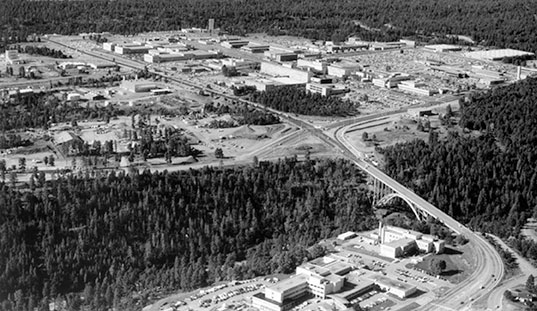Three Physics Sites Honored for Their Historic Roles
By Paul Halpern

The APS Historic Sites Committee has selected three sites this year pivotal to the development of physics to be honored for their roles. The sites are the IBM Thomas J. Watson Research Center, Los Alamos National Laboratory, and the Carnegie Institution of Washington Division of Terrestrial Magnetism. A plaque will be placed at each of these sites to commemorate their place in physics history.
Headquarters for IBM’s Research Division, the Thomas J. Watson Research Center in Yorktown Heights, New York has been the home of numerous physicists and physics advances. Notable physicists working there have included Rolf Landauer, Charles H. Bennett and 1973 Nobel laureate Leo Esaki who received the prize for electron tunneling in solids. Breakthroughs at the Watson Research Center have included superlattice crystals, dynamic random access memory (DRAM), field effect transistor (FET) scaling laws, amorphous magnetic films for optical storage and thin-film magnetic recording heads.
Los Alamos National Laboratory began as a top-secret military site, established by the US Army in 1942 as the home of the Manhattan Project on the grounds of a boys school in the mountains of northern New Mexico. A teacher’s house, made of logs and stone, was converted for use as the home of physicist J. Robert Oppenheimer, scientific leader of the project. “Oppie,” as he was affectionately known, lived at the home between 1943 and 1945, along with his wife Kitty, son Peter and daughter Katherine (born in December 1944) as he led the program to design, build and test the first atomic bomb.
Today, the Oppenheimer house is one of nine buildings intact from that era, on a block preserved as part of the Los Alamos historic district. South of his house was the home of Nobel Laureate Hans Bethe, head of the laboratory’s Theoretical Division during the war. Other wellknown physicists who resided on that block during the wartime era included James Chadwick, Richard Feynman and Enrico Fermi. The Los Alamos National Laboratory is currently the home of numerous research projects, for civilian as well as military purposes.
The Carnegie Institute of Washington Department of Terrestrial Magnetism (DTM) was founded in 1904 in Washington, DC. While its primary initial goal was to map the Earth’s magnetic field, that aim was accomplished in 1929. Thereafter, the DTM’s mission has expanded and researcher have focused on numerous other terrestrial and astronomical projects, including the search for exoplanets. Starting in the late 1960s, and throughout the 1970s, astrophysicist Vera Rubin, along with Kent Ford and other colleagiues, began a study of the speeds of stars in spiral galaxies. Through these studies Rubin showed how the visible mass of spiral galaxies was not enough to account for the stellar motions, particularly of peripheral stars. This missing mass became known as dark matter. Today, the nature of dark matter is one of the greatest mysteries in physics.
The APS Historic Sites Initiative was established in 2004 to help make the public more aware of physics and to increase awareness among physicists themselves of the discipline’s history. Each honoree receives a plaque during a special ceremony, often by a member of the APS presidential line. More information about the APS Historic Sites Initiative and a list of past honorees can be found at the Historic Sites Initiative web page.
Paul Halpern is a Professor of Physics and Fellow in the Humanities at the University of the Sciences in Philadelphia.
The articles in this issue represent the views of their authors and are not necessarily those of the Forum or APS.
